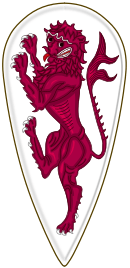Henry IV of Castile
| Henry IV | |
|---|---|
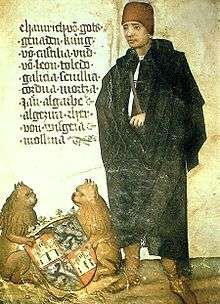 | |
| King of Castile and León | |
| Reign | 22 July 1454 – 11 December 1474 |
| Predecessor | John II |
| Successors | Isabella I |
| Born |
5 January 1425 Valladolid, Spain |
| Died |
11 December 1474 (aged 49) Madrid, Spain |
| Burial | Santa María de Guadalupe, Extremadura, Spain |
| Consort |
Blanche II of Navarre Joan of Portugal |
| Issue | Joanna La Beltraneja |
| House | Trastámara |
| Father | John II of Castile |
| Mother | Maria of Aragon |
| Religion | Roman Catholicism |
Henry IV of Castile (Castilian: Enrique IV) (5 January 1425 – 11 December 1474), King of the Crown of Castile, nicknamed the Impotent (ruled 1454–1474), was the last of the weak late medieval kings of Castile. During Henry's reign the nobles increased in power and the nation became less centralised.
Biography
Prince
He was born in 1425 in the Casa de las Aldabas (since destroyed) in Teresa Gil street of Valladolid. He was the son of John II of Castile and Maria of Aragon, daughter of King Ferdinand I of Aragon. He displaced his older sister, Eleanor, and became heir apparent to the Castilian throne as the Prince of Asturias.[1]
At the time of his birth, Castile was under control of Álvaro de Luna, Duke of Trujillo, who intended to select Henry's companions and direct his education. The companions of his own age included Juan Pacheco, who became his closest confidant. The struggles, reconciliations and intrigues for power among the aristocracy, Álvaro de Luna, and the Infantes of Aragon would be constant.
On 10 October 1444, he became the first and only prince of Jaén.[2] In 1445 he won the First Battle of Olmedo, defeating the Infantes of Aragon. After the victory at Olmedo, Álvaro de Luna's power waned, and Prince Henry and Juan Pacheco's influence grew.
King
John II died on 20 July 1454. Henry was proclaimed king the following day.
One of his first priorities was the alliance with Portugal. He achieved this by marrying a second time, to Joan of Portugal in 1455, and by meeting Afonso V of Portugal in Elvas in 1456. His other main concerns were the possibility of intervention from John II of Navarre, establishing peace with France and Aragon, and pardoning various aristocrats.[3][4] Henry convened the Cuéllar Courts to launch an offensive against the Emirate of Granada.[5] The campaigns of 1455 and 1458 developed into a war of attrition based on punitive raids and avoiding pitched battles. It was not popular with the aristocracy or the people. Juan Pacheco, the Marquis of Villena, and his brother Pedro Girón were put in charge of government decisions. The king also took other advisors, such as Beltrán de la Cueva, Miguel Lucas de Iranzo and Gómez de Cáceres to balance against their influence.[6]
In 1458, Alfonso V of Aragon died and was succeeded by his brother, John II of Navarre. John resumed his interference in Castillian politics, supporting the aristocratic opposition to Juan Pacheco's ambitions. With the support of the king, Pacheco moved to seize Álvaro de Luna's assets, but his widow allied herself with the Mendoza family, causing a division among the aristocracy. This process resulted in the formation of a League of Nobles in March 1460.[7][8][9] They raised a large number of noblemen, took control of expenditure, and gained the acceptance of Alfonso of Castille, the King's half brother and Prince of Asturias.[10]
To counteract John II of Aragon's politicking Henry IV reacted by invading Navarre in support of Charles, Prince of Viana. Charles was heir to Navarre, and he revolted against his father in 1450 when he refused to cede the throne of Navarre.[11] The campaign was a military success, but the Castillian king made peace with the League of Nobles in August 1461 to ward off the power of the Mendozas, which had allowed John II of Aragon to intervene in Castille.[12]
John II of Aragon was in conflict with the Principality of Catalonia, and on the death of John's son, Charles of Viana, the principality elected Henry to be count of Barcelona[13] on 11 August 1462. Henry IV's intervention was framed as a rivalry between him and John, making Catalonia an unstable point in the Crown of Aragon. But Henry IV was unsuccessful, and the Castillian economy would suffer from an enmity with France, who had supported John II of Aragon with the Treaty of Bayonne.[14] Henry therefore agreed to a settlement in the Judgment of Bayonne, resulting in the abandonment of the Catalans.[15]
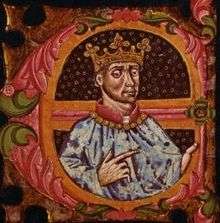
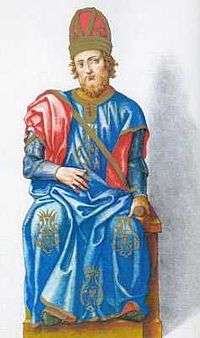
Marital politics
Marriage to Blanche II of Navarre
Prince Henry celebrated his marriage to the infanta Blanche (who later became queen Blanche II of Navarre) in 1440, when he was 15 years old. The cardinal Juan de Cervantes presided over the official ceremony. Her parents were Blanche I of Navarre and John II of Navarre. The marriage had been agreed in 1436 as part of the peace negotiations between Castille and Navarre.[16] The dowry included territories and villas that had previously belonged to Navarre but had been won by the Castillian side during the war, and the Castillians agreed to hand the lands back provided they would be given them back again as part of this dowry.[17]
In May 1453, the bishop of Segovia Luis Vázquez de Acuña annulled the marriage of Henry and Blanche, on the grounds of Henry's sexual impotence due to a curse.[18][19] This neatly reflected the recent political changes: Castille had supported Charles, Prince of Viana in his fight against John II of Aragon for the Navarrese throne since 1451, and Álvaro de Luna, Duke of Trujillo had been executed in May 1453, leaving Henry with greater control of Castille.[20] Henry alleged that he had been incapable of sexually consummating the marriage, despite having tried for over three years, the minimum period required by the church. Other women, prostitutes from Segovia, testified that they had had sexual relations with Henry, which is why he blamed his inability to consummate the marriage on a spell. Henry's alleged "permanent impotence" only affected his relations with Blanche. Blanche and Henry were cousins, and he was also a cousin of Joan of Portugal, whom he wanted to marry instead. Therefore, the reason he used to seek the annulment was the sort of spell that only affected his ability to consummate this one marriage, and would not cause any problems for him with other women.[21] Pope Nicholas V corroborated the decision in December of the same year in a papal bull and provided a papal dispensation for Henry's new marriage with the sister of the Portuguese king.[22][23]
One of Henry's detractors, the historian Alfonso de Palencia, wrote that the marriage had been a sham and accused Henry of despising his wife and planning to commit adultery to bear children. According to Palencia, Henry demonstrated "most extreme abhorrence" to his wife, and indifference to the confines of marriage.[24] However, in 1462 Blanche gave up her right to the Navarre throne so Henry could take it, and selected him as her protector, against her own father John II of Aragon.
The remoteness of Aragon led to an approach to Portugal. In March 1453, before his divorce from Blanche was finalised, there was no record of negotiations for the new marriage between Henry and Joan of Portugal, sister of the king Alfonso V of Portugal. The first marital approaches were made in December of that year, although the negotiations were long and the proposal wasn't definitively agreed until February 1455.[23] According to chroniclers of the time, Joan did not provide a dowry and would not have to return anything even if the marriage turned out to be a failure. The length of the negotiations and the concessions could be interpreted as caused by the concerns about the rumours of Henry's impotence.[25] The wedding was celebrated in May 1455, but without an affidavit of official bull authorizing the wedding between them, although they were first cousins (their mothers were sisters) and second cousins (their paternal grandmothers were half-sisters). On 28 February 1462, the queen gave birth to a daughter Joanna la Beltraneja, whose paternity came into question during the conflict for succession to the Castillian throne when Henry died.
Henry IV was twenty-six years old when his half-sister Isabella was born. She was the daughter of his father's second marriage in 1447, to Isabella of Portugal. Henry made a number of attempts throughout his reign to arrange a politically advantageous marriage for his much younger sister. The first attempt was when the six-year-old Isabella was betrothed to Ferdinand, son of John II of Navarre (a cadet branch of the House of Trastámara).[26] This arrangement, however, did not last long.
Civil war
Before the birth of his daughter, Henry convened the Court in Madrid and Joanna was sworn in as Princess of Asturias. But a conflict with the nobility was created when Beltrán de la Cueva deposed Juan Pacheco, the Marquis of Villena, and his brother Pedro Girón, Master of Calatrava from Henry's court.[27][28] This caused a change in alliances: Mendoza began to support the king, and Pacheco revived the Aristocratic League aimed at eliminating the influence of Beltrán de la Cueva. They had doubts on the paternity of Henry's daughter, saying that she was in fact the daughter of the new favourite, and started referring to her as "the Beltraneja".[29] The league of nobles, controlling the king's siblings Alfonso and Isabella, forced Henry at the 1464 Representation of Burgos to repudiate Joanna and recognize Alfonso as his official heir. Alfonso then became Prince of Asturias, a title previously held by Joanna. Henry agreed to the compromise with the stipulation that Alfonso someday marry Joanna, to ensure that they both would one day receive the crown.
Not long after this, Henry reneged on his promise and began to support his daughter's claim once more. The nobles in league against him conducted a ceremonial deposition-in-effigy of Henry outside the city of Avila and crowned Alfonso as a rival king. This event is known in history as the Farce of Avila. Shortly thereafter, Alfonso began handing out land and titles as if he were already uncontested ruler. A civil war began. The most notable clash was at the Second Battle of Olmedo in 1467, which concluded as a draw.
However, in 1468 at the age of only 14, Alfonso died of a sickness, most likely the plague (Although poison and slit throat as alternative causes of death have been suggested). His will left his crown to his sister, Isabella, who was asked to take her brother's place as the champion of the rebels. Shortly thereafter at the negotiation of Toros de Guisando, in which she and her allies received most of what they desired, Henry agreed to exclude Joanna la Beltraneja from the succession, and to recognize Isabella as his official heir. Though Henry continued to resist this decision when possible, his actions were ineffective, and he remained at peace with Isabella for the rest of his reign. Isabella became Castile's next monarch when he died in 1474.
After the death of the king war started in Castile. Joanna was supported by Portugal, while the eventual winner, Henry's half-sister Isabella I of Castile had the support of Aragon because of her marriage to Ferdinand II of Aragon, and later in the war, France also supported her right to the throne.
Debate over his health and sexuality
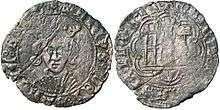
In 1440, at the age of fifteen, he was married to Blanche II of Navarre. The marriage was never consummated. In 1453, after thirteen years, Henry sought a divorce. An official examination confirmed the virginity of Blanche, and a priest questioned the prostitutes of Segovia, who confirmed that Henry was sexually capable. Blanche was sent home; eight years later, she became de iure Queen of Navarre and died under strange circumstances.
In 1455, Henry married Joan of Portugal, sister of Afonso V of Portugal. After six years of marriage, in 1462, she gave birth to a daughter, Joan, nicknamed "La Beltraneja". Six years after the birth of the throne's heir, part of the nobility of Castile revolted against the king. The rebels claimed that the princess was not the daughter of the king, but actually the daughter of Beltrán de La Cueva, 1st Duke of Alburquerque (thus the nickname "Beltraneja"). This hypothesis was reinforced when the Queen had another two children with the nephew of a Bishop. Though many contemporary historians and chroniclers believed Henry was impotent, even homosexual,[30] the royal chronicles of his reign were all written or revised during the reign (and under the influence) of Isabella I, his half-sister and ultimate successor, whose strong interest in proving Joan illegitimate renders these accounts at least partially suspect. The question of Joan's paternity and right to the throne is therefore not firmly answerable, given the lack of available reliable sources.
The doubt of her legitimacy as an heir, the weakness of the king, the adultery of the queen, and the unruliness of the nobility all set the stage for a struggle for succession after Henry's death. Henry divorced his wife after her scandalous behavior with Bishop Fonseca's nephew. After a long period of conflict between the rival factions, Henry finally agreed to name Isabella his successor, in Guisando (Avila), provided she allow him to arrange her strategic marriage. Isabella would go on to break this stipulation of the agreement.
Henry died in 1474 and was buried at Santa María de Guadalupe, next to his mother.
Appearance
Henry was a striking man. Tall, blonde and well-built, he had broken his nose as a child. The accident left him with an adult face that made him look, depending on whom you listened to, like either a terrifying lion or a foolish monkey.[31]
Ancestry
| Ancestors of Henry IV of Castile | ||||||||||||||||||||||||||||||||||||||||||||||||||||||||||||||||||||||||||||||||||||||||||||||||||||||||||||||||||||||||||||||||||||||||||||||||||||||||||||||||||||||||||||||||||||||||||||||||||||||||||||||||||||||||||||||||||||||||||||||||||||||||||||||||||||||||||||||||||||||||||||||||||||||||||||||||||||||||||||||||||||||||||||||||||||||||||||||||||||||||||||||||||||||||||||||||||||||||||||||||||||||||||||||||||||||||||||||||||||||||||||||||||||||||||||||||||||||||||||||||||||||||||||||||||||||||||||||||||
|---|---|---|---|---|---|---|---|---|---|---|---|---|---|---|---|---|---|---|---|---|---|---|---|---|---|---|---|---|---|---|---|---|---|---|---|---|---|---|---|---|---|---|---|---|---|---|---|---|---|---|---|---|---|---|---|---|---|---|---|---|---|---|---|---|---|---|---|---|---|---|---|---|---|---|---|---|---|---|---|---|---|---|---|---|---|---|---|---|---|---|---|---|---|---|---|---|---|---|---|---|---|---|---|---|---|---|---|---|---|---|---|---|---|---|---|---|---|---|---|---|---|---|---|---|---|---|---|---|---|---|---|---|---|---|---|---|---|---|---|---|---|---|---|---|---|---|---|---|---|---|---|---|---|---|---|---|---|---|---|---|---|---|---|---|---|---|---|---|---|---|---|---|---|---|---|---|---|---|---|---|---|---|---|---|---|---|---|---|---|---|---|---|---|---|---|---|---|---|---|---|---|---|---|---|---|---|---|---|---|---|---|---|---|---|---|---|---|---|---|---|---|---|---|---|---|---|---|---|---|---|---|---|---|---|---|---|---|---|---|---|---|---|---|---|---|---|---|---|---|---|---|---|---|---|---|---|---|---|---|---|---|---|---|---|---|---|---|---|---|---|---|---|---|---|---|---|---|---|---|---|---|---|---|---|---|---|---|---|---|---|---|---|---|---|---|---|---|---|---|---|---|---|---|---|---|---|---|---|---|---|---|---|---|---|---|---|---|---|---|---|---|---|---|---|---|---|---|---|---|---|---|---|---|---|---|---|---|---|---|---|---|---|---|---|---|---|---|---|---|---|---|---|---|---|---|---|---|---|---|---|---|---|---|---|---|---|---|---|---|---|---|---|---|---|---|---|---|---|---|---|---|---|---|---|---|---|---|---|---|---|---|---|---|---|---|---|---|---|---|---|---|---|---|---|---|---|---|---|---|---|---|---|---|---|---|---|---|---|---|---|---|---|---|---|---|---|---|---|---|---|---|---|---|---|---|---|---|---|---|---|---|---|---|---|---|---|---|---|---|---|---|---|---|---|---|---|---|---|---|---|---|---|---|---|---|---|---|---|---|---|---|---|---|---|---|---|---|---|---|---|---|---|---|---|---|---|---|---|---|---|---|---|---|---|---|---|---|---|---|---|---|---|---|---|---|---|---|---|---|---|---|---|---|---|
| ||||||||||||||||||||||||||||||||||||||||||||||||||||||||||||||||||||||||||||||||||||||||||||||||||||||||||||||||||||||||||||||||||||||||||||||||||||||||||||||||||||||||||||||||||||||||||||||||||||||||||||||||||||||||||||||||||||||||||||||||||||||||||||||||||||||||||||||||||||||||||||||||||||||||||||||||||||||||||||||||||||||||||||||||||||||||||||||||||||||||||||||||||||||||||||||||||||||||||||||||||||||||||||||||||||||||||||||||||||||||||||||||||||||||||||||||||||||||||||||||||||||||||||||||||||||||||||||||||
References
- ↑ Martín, p. 41. The title was created in 1388 but both Henry III and John II ascended to the throne before reaching the necessary age to become princes.
- ↑ In the cultural magazine of Don Lope de Sosa (1913-1930), creator of the official chronicle of the province of Jaén, D. Alfredo Cazabán Laguna (1870-1929) mentions the creation of the principality of Jaén in an article for King John II (10 October 1444) with the intention of restabilising the following a revolt of the aristocracy of Baeza, which affected the whole province and was fronted by the Bishop D. Gonzalo de Zúñiga and his city. The principality was given to his son and heir Henry when he took the title Prince of Asturias in 1444, and his title became Prince of Asturias and Jaén. The province stabilised with his accession to the throne, so the principality was repealed.
- ↑ Martín, p. 73. Henry frees the counts of Alba and Treviño, prisoners since the Záfraga coup, and annulled the exile of the Admiral Don Fadrique
- ↑ Los Trastamara y la Unidad Española. Ediciones Rialp. 1981. pp. 407–408. ISBN 9788432121005.
- ↑ Martín, p. 73
- ↑ Iglesias Rodríguez, Juan José; García Fernández, Manuel (1995). Universidad de Sevilla, ed. Osuna entre los tiempos medievales y modernos (siglos XIII-XVIII). p. 79. ISBN 9788447202218.
- ↑ Franco Silva, Alfonso (1996). La fortuna y el poder: estudios sobre las bases económicas de la aristocracia castellana: S. XIV-XV. Servicio Publicaciones Universidad de Cádiz. p. 297. ISBN 9788477863021.
- ↑ Monsalvo Antón, José María (1988). El sistema político concejil: el ejemplo del señorío medieval de Alba de Tormes y su concejo de villa y tierra. Universidad de Salamanca. p. 47. ISBN 9788474814842.
- ↑ Leralta, Javier (2008). Apodos reales: historia y leyenda de los motes regios. Silex Ediciones. p. 322. ISBN 9788477372110.
- ↑ Álvarez Palenzuela, Vicente Ángel (2007). Historia de España de la Edad Media. Editorial Jethro. p. 764. ISBN 9788434466685.
- ↑ Martín, p. 55
- ↑ Los Trastamara y la Unidad Española. Ediciones Rialp. 1981. pp. 414–415. ISBN 9788432121005.
- ↑ Corteguera, Luis R. (2002). For the Common Good: Popular Politics in Barcelona, 1580-1640. Cornell University Press. p. 13. ISBN 9780801437809.
- ↑ Martín, José-Luis (2003). Enrique IV de Castilla: Rey de Navarra, Príncipe de Cataluña. Editorial NEREA. p. 125. ISBN 9788489569829.
- ↑ María del Pilar, Rábade Obradó; Ramírez Vaquero, Eloísa; Utrilla Utrilla, Juan F. (2005). Ediciones AKAL, ed. La dinámica política. p. 183. ISBN 9788470904332.
- ↑ Valdeón Baruque, Julio, "Los Trastámaras", p.135
- ↑ Martín, p. 30
- ↑ Edwards, John; Lynch, John (2008). Edad Moderna: Auge del Imperio, 1474-1598. 4. Editorial Critica. pp. 17–18. ISBN 9788484326243.
- ↑ Testimonial of the divorce ruling between Prince Henry and the infanta Blanche, included in Collection of unedited documents on the history of Spain, vol. XL, pages. 444-450.
- ↑ Martín, pp. 112-113
- ↑ Martín, José Luis, "Enrique IV", ed. Nerea, Hondarribia, 2003, pp. 312-313
- ↑ Martín, pp.62-63
- 1 2 Ohara, p. 59
- ↑ Ohara, p.57
- ↑ Martín, pp. 65-67
- ↑ Plunkett,Ierne. Isabel of Castile. The Knickerbocker Press, 1915, p. 35
- ↑ María del Pilar, Rábade Obradó; Ramírez Vaquero, Eloísa; Utrilla Utrilla, Juan F. (2005). Ediciones AKAL, ed. La dinámica política. p. 185. ISBN 9788470904332.
- ↑ Álvarez Palenzuela, Vicente Ángel (2007). Editorial Ariel, ed. Historia de España de la Edad Media. p. 777. ISBN 9788434466685.
- ↑ María del Pilar, Rábade Obradó; Ramírez Vaquero, Eloísa; Utrilla Utrilla, Juan F. (2005). Ediciones AKAL, ed. La dinámica política. p. 185. ISBN 9788470904332.
- ↑ es:Daniel Eisenberg, "Enrique Cuarto and Gregorio Marañón," Renaissance Quarterly, 29.1, 1976, pp. 21-29.
- ↑ Giles Tremlett, "Catherine of Aragon, Henry's Spanish Queen", p.13
- Miller, Townsend: The Castles and the Crown. Coward-McCann, New York, (1963).
External links
| Henry IV of Castile Born: 5 January 1425 Died: 11 December 1474 | ||
| Regnal titles | ||
|---|---|---|
| Preceded by John II |
King of Castile and León 1454–1474 |
Succeeded by Isabella I |
| Spanish royalty | ||
| Preceded by Infanta Eleanor |
Prince of Asturias 1425–1454 |
Vacant Title next held by Infanta Joanna |
| Titles in pretence | ||
| Preceded by John II |
— TITULAR — King of Aragon Count of Barcelona (in opposition to John II) 1462–1463 |
Succeeded by Peter V |
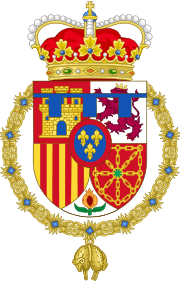
.svg.png)
